Get out the Crayola! Try and stay within the lines.
Despite the childish name, this technique is VERY powerful.
This technique is called by a few names. Amongst them are simple coloring, multi-coloring, colors.
I prefer just coloring. I also prefer to extend this idea to include any technique
that is performed on just one type of candidate - or just one number, if you prefer.
Xwings, Swordfish, Jellyfish, Finned Xwings, Finned Swordfish, Locked Candidates, and
many other techniques involving just one type of candidate can be placed under the tag,
coloring.
Simple Coloring Example
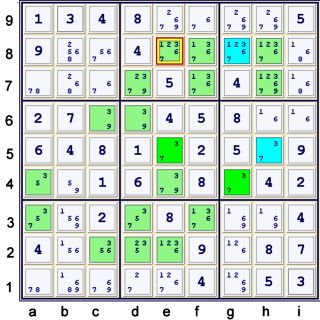
In this example, all the possible locations for 3's are highlighted by some sort of color.
In column g, the 3's are limited to two locations, g4 and g8. If g8=3, then clearly
e8 cannot be 3. If however g4=3, then h5<>3, thus e5=3. In this case, again e8 cannot be
3. The term, coloring is derived from the common illustration of this technique
using colors to deduce the possible eliminations. In a proof, I would present this idea
as:
- fc on 3's: g8 == g4 -- h5 == e5 forbids e8=3
Whoa! What did I just write?!
Here is a brief key to terminology above:
- fc
- forbidding chain
- A == B
- A OR B, equivalent to A Union B
- A -- B
- (not A) OR (not B), equivalent to A forbids B
- g8
- shorthand for g8=number, in this case: g8=3
The reason that I introduce
forbidding chains at this time is quite simple:
All the sudoku solving techniques, except perhaps those involving uniqueness of solution, fit
under one umbrella,
Forbidding Chains and
Forbidding Matrices.
Blog pages currently under construction will discuss forbidding chains in some detail.
More Complex Coloring
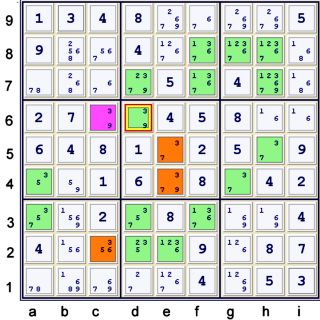
This example is from the same puzzle as the first, after preforming the previously prescribed
exclusion. The logic is colorfully highlighted, but here is an explanation:
- If c6=3, then clearly d6 cannot be 3
- Since 3's in column c are limited to c2,c6 - If c6<>3 then c2=3
- If c2=3, then without even looking at the grid, e2 cannot be 3
- Since 3's in column e are limited to e2,e4,e5 - If e2<>3 then 3's must exist within e45
- Either one of e4, e5 being 3 prevents d6 from being 3
Conclude therefor that in every event, d6=3 is impossible and therefor forbidden. In a proof, this
step could look like this:
- fc on 3's: c6 == c2 -- e2 == e45 forbids d6=3
Again, do not be disheartened by the
forbidding chain language. It is not required
to understand this idea - it will help though, both in clear
communication and
thought once fully explained.
Technique names are almost as much fun as the puzzles. The example above
is a Finned X wing. However, if one generalizes the idea of coloring,
then learning each specific technique involving just one number is superfluous.
The elimination above is missed by programs such as the solver in Simple Sudoku
merely because of the grouping of e45=3. In my humble opinion, such a grouping adds
little complexity.
Coloring Example From Tough Puzzle of 12/23/06
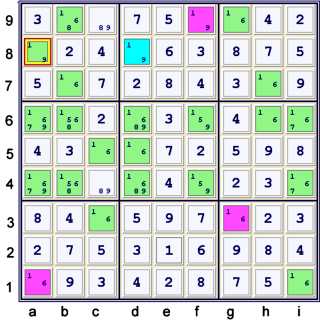
This example is one step deeper then the previous two. Here we have:
- 1's in box e8 limited to two locations: d8,f9
- 1's in column g limited to two locations: g9,g3
- 1's in row 1 limited to two locations:i1,a1
- Clearly: d8=1 or f9=1
- If f9=1, then g9<>1 thus g3=1
- If g3=1, then i1<>1 thus a1=1
- Thus, sans further grid examination, we know that a8<>1
This step could be written as:
fc on 1's: d8 == f9 -- g9 == g3 -- i1 == a1 forbids a8=1
Interesting coloring example

In this example, think of the blue cell at c6 as the starting point.
- If c6=1, then c3<>1
- If c6<>1, then both a4=1 and h6=1
- If a4=1 and h6=1, then neither a8=1 nor h8=1
- If neither a8=1 nor h8=1, then e8=1
- If e8=1, then e2<>1
- If e2<>1, then d3=1
- Conclude: If c6=1, then c3<>1. If c6<>1, then still c3<>1. Thus, c3=1 is not possible
This complex coloring idea could be presented in a proof as:
fc on 1's: d3 == e2 -- e8 =={fc on 1's: c6 == a4 -- a8 == h8 -- h6 == c6} forbids c3=1
Do not be discouraged - most coloring that is needed to solve puzzles is not nearly
as difficult. Nevertheless, understanding an idea such as this one is certainly needed
to tame the
monster puzzles without guessing.
Many solvers would use multi-coloring for the elimination above. In most
cases, two colors is quite enough. In fact, one color is enough for the elimination above.
Thinking clearly about coloring involves thoughtful partioning of native strong sets.
Native strong set: Any grouping of puzzle possibilities that contains
at least one item that
must be true.
Diabolic Coloring Example
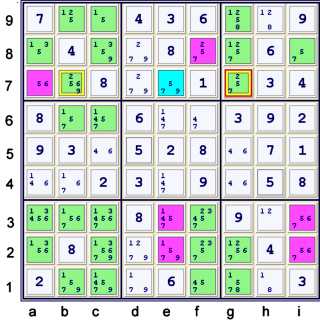
If you can justify the two eliminations above, you are well on your way to becoming expert at coloring.
fc on 5's: e7== f8 -- ai8,e7 =={swordfish on 5's at a237,e23,i23} forbids bg7=5
Symmetrical presentation
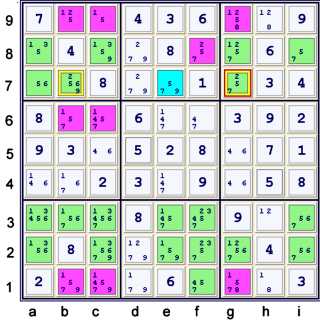
The following puzzle links are provided for practice in coloring: